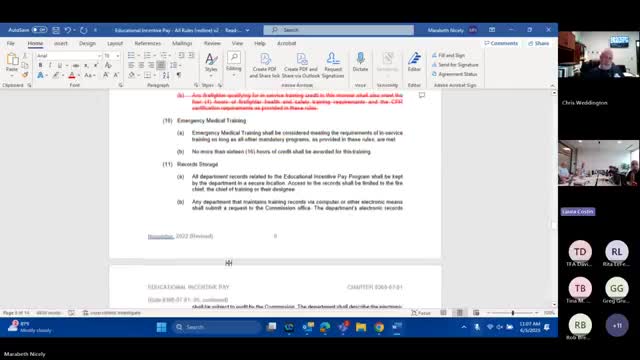Firefighter Training Incentives Spark Debate Over Legislative Loopholes
June 07, 2025 | Commerce & Insurance, Deparments in Office of the Governor, Organizations, Executive, Tennessee
This article was created by AI summarizing key points discussed. AI makes mistakes, so for full details and context, please refer to the video of the full meeting. Please report any errors so we can fix them. Report an error »

In a recent meeting of the FFC Rules Subcommittee, discussions centered around the complexities of training requirements for emergency service personnel in Tennessee, highlighting a significant loophole that could impact both firefighters and police officers.
One of the key topics was the ongoing debate about the training hours required for emergency medical services (EMS) personnel. Currently, there are regulations that limit the number of hours that can be counted towards in-service training, which has raised concerns among members about the adequacy of training for those in the field. The committee discussed the existing requirement of 24 hours of training every two years, with some members advocating for a review of these standards to ensure they meet the evolving needs of emergency responders.
A particularly contentious issue arose regarding the ability of police officers and volunteer firefighters to receive dual training incentives. The current legislation allows police officers to benefit from both post-education incentives and volunteer education incentives, creating a situation where they can "double dip." In contrast, career firefighters who also serve as volunteer firefighters are not afforded the same opportunity, leading to questions about fairness and equity in training recognition.
The committee acknowledged that this loophole could lead to confusion and inequities among emergency service personnel. Members expressed concern that while some individuals may benefit from this dual recognition, others, particularly career firefighters, are left at a disadvantage. The discussion underscored the need for a comprehensive review of the training regulations to ensure that all emergency responders are treated equitably and that the training they receive is relevant and sufficient for their roles.
As the committee continues to explore these issues, the outcomes of their discussions could have significant implications for the training and professional development of emergency service personnel across Tennessee. The next steps will involve further examination of the current laws and potential recommendations for legislative changes to address these disparities.
One of the key topics was the ongoing debate about the training hours required for emergency medical services (EMS) personnel. Currently, there are regulations that limit the number of hours that can be counted towards in-service training, which has raised concerns among members about the adequacy of training for those in the field. The committee discussed the existing requirement of 24 hours of training every two years, with some members advocating for a review of these standards to ensure they meet the evolving needs of emergency responders.
A particularly contentious issue arose regarding the ability of police officers and volunteer firefighters to receive dual training incentives. The current legislation allows police officers to benefit from both post-education incentives and volunteer education incentives, creating a situation where they can "double dip." In contrast, career firefighters who also serve as volunteer firefighters are not afforded the same opportunity, leading to questions about fairness and equity in training recognition.
The committee acknowledged that this loophole could lead to confusion and inequities among emergency service personnel. Members expressed concern that while some individuals may benefit from this dual recognition, others, particularly career firefighters, are left at a disadvantage. The discussion underscored the need for a comprehensive review of the training regulations to ensure that all emergency responders are treated equitably and that the training they receive is relevant and sufficient for their roles.
As the committee continues to explore these issues, the outcomes of their discussions could have significant implications for the training and professional development of emergency service personnel across Tennessee. The next steps will involve further examination of the current laws and potential recommendations for legislative changes to address these disparities.
View full meeting
This article is based on a recent meeting—watch the full video and explore the complete transcript for deeper insights into the discussion.
View full meeting
